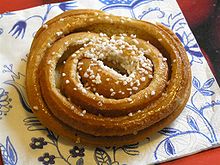Kanelbulle
The Kanelbulle (from Swedish kanel = cinnamon and bulle = snail / yeast particles; plural kanelbullar ), a kind of cinnamon bun , is a Swedish baked goods specialty . It is one of Sweden's most famous and popular pastries and was introduced in the 1920s when the availability of baking ingredients increased after the First World War .
The Kanelbulle consists mainly of wheat flour , milk , yeast , sugar and butter or margarine . Often the dough is seasoned with cardamom . The filling usually consists of butter / margarine, sugar and cinnamon ; but other spices, fruits and the like are also possible. The bullar be with an opened egg coated with coarse sugar sprinkled.
Kanelbullar are usually round, in the shape of a snail. However, other forms such as twin snails, knots and buns also occur. To maintain their shape while walking, baking and transporting the bullar are often placed in folded paper molds that can be bought in any grocery store.
Kanelbullar are part of every coffee party and are the favorite pastry of many children, although they usually enjoy them with milk. According to a Swedish convention, the coffee guest must first eat such a relatively filling snail before he can help himself to the cake pieces and cookies.
In 1999 Hembakningsrådet introduced "Kanelbullens Day" ( Kanelbullens dag ), which is celebrated annually on October 4th (especially by the Swedish economy).
The Kanelbulle is described in Astrid Lindgren's novels as cinnamon rolls. Due to the similar shape, the at-sign @ is often referred to as kanelbulle in Sweden .
See also
- Pulla
- Hamburger Franzbrötchen
Web links
- Kanelbullens dag with articles on the history of the Kanelbullar (swed.)
